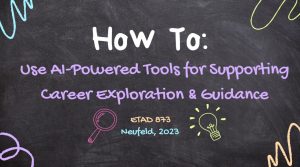5 Supporting Career Exploration and Guidance with AI-Powered Tools
Paul Neufeld

“Follow the Signs”. Image created with Magic Media image generator.
Prompt: A student is standing, looking at a signpost. The signpost has many arrows on it. Each arrow is pointing in a different direction. Cartoon. Colourful.
Introduction

The Challenge
One of the most important decisions individuals make in their lifetime is choosing a career, as it can impact their social, economic, and emotional well-being (Gati & Kulcsar, 2021). Career exploration can begin at an early age (i.e., as an adolescent), and most of us can relate to the difficulty of answering the conundrum of “What do I want to be when I grow up?”
Per the OECD (2004), “career guidance refers to services intended to assist people, of any age and at any point throughout their lives to make educational, training, and occupational choices and to manage their careers” (p. 19). Therefore, family, friends, teachers, and advisors (e.g., guidance counsellors) can all play a role in providing career guidance to students – supporting them in their pursuit of answering this conundrum for themselves. Under the OECD definition, technology can also be considered a tool for supporting career guidance.
The Opportunity
Concerning career exploration and guidance, technology has traditionally been used in the following three ways:
- Providing learning and career information supporting career building.
- Providing automated interaction like career assessments, simulations, or games.
- Providing choices of communication (Westman et al., 2021).
Artificial Intelligence (AI) is a technology that is rapidly evolving and transforming our society, and one industry with incredible potential for AI applications is education (Rouhiainen, 2019). Technology mogul Bill Gates also believes there are countless ways that AI can assist teachers, including advising on career planning (Gates, 2023). This is corroborated by Gati and Kulcsar (2021), who identify that “it can be expected that the developments in artificial intelligence will also impact career decision making” (p. 12).
Developments in AI have led to new and novel opportunities to provide access to career guidance on demand, as well as expand the range of services offered (Westman et al., 2021). AI can also assist individuals with uncovering various careers as options they may not have considered otherwise (Reddy, 2023). A study performed by Westman et al. (2021) found that “students welcomed the use of AI in career guidance” (p. 48). Thus, AI provides an opportunity to support and enhance the career guidance provided to students – expanding upon the traditional use of technology for such applications.
The Technology (i.e., AI-Powered Tools)
Table 1 summarizes three specific AI-powered tools (all web-based) that were researched for potential use in supporting students with career exploration and guidance.
Table 1 – AI-Powered Career Exploration and Guidance Tools

These three AI-powered tools help users identify possible career options by asking personal questions related to an individual’s interests, skills, values, etc. This chapter subsequently covers using AI-powered tools such as these, to support students, teachers, and advisors with career exploration and guidance – including examples of how the aforementioned tools can be utilized.
Critical Media Literacy (connection to Curriculum)

General Critical Media Literacy
We live in the “Information Age”[1], and as such, educators must support students in developing the necessary skills to assess the content, quality, and consistency of the information readily available over the Internet. Students can develop critical media literacy by analyzing the sources, facts, and opinions presented online (Historica Canada, 2023). This critical media literacy is especially important when we use technology, such as AI, to complete research and respond to our queries using data collected from the Internet – including recommendations on possible careers.
As stated by Mollick and Mollick (2023), “AI is not perfect and is prone to errors, hallucinations, and biases, which should not be left unchecked” (p. 3). Therefore, when using AI-powered tools to support career exploration and guidance, students, teachers, and advisors should actively and critically review the outputs, check with reliable sources, and complement any output with their unique perspectives and insights. In order to increase the awareness, understanding, competencies, and critical thinking of students concerning AI, AI should become part of everyday learning activities, not merely a separate application (Westman et al., 2021). “To reap rewards from its potential and activate hard thinking and protect against its risks, educators should play an active role in teaching students how and when to use AI as they instill best practices in AI-assisted learning” (Mollick & Mollick, 2023, p. 3).
To assist students with critical media literacy, it is also recommended that educators and advisors discuss the nature of future careers and the role that AI may play in those careers. For example, students must understand that over time, more repetitive and routine tasks will be automated and performed by AI (Rouhiainen, 2019). This is corroborated by Westman et al. (2021), who recommends that “AI-related competencies should be built up in education as they are required for future work environments where AI is utilized” (p. 47). CERIC (2023) has published a report titled Career Development in 2040: 10 Major Changes Impacting the Future of Work and Workers in Canada, which provides insights on major trends and changes in Canada that are likely to impact future careers (including AI) and can serve as a good reference for these discussions.
Tool-Specific Critical Media Literacy
While the three specific AI-powered career exploration and guidance tools (i.e., CareerHub AI, Existential, Explain Like I’m Five) do not raise any significant concerns, three key things to be cautious of when using AI-powered tools such as these are:
- While using each tool is potentially free, these tools are developed by companies likely trying to make money by converting free users to paid users and/or benefit from collecting users’ data. Therefore, these companies may be more focused on optimizing their financial gains rather than the resulting outcomes for the users.
- It is essential for students to research any recommended careers from each tool if they are interested in them. Similarly, if a student is interested in a career not recommended by the tools, this does not mean they should abandon these interests. The outputs from these tools should be considered a recommendation only, and the onus is on the student (with assistance from those providing career guidance) to take a proactive role in defining and deciding upon an intended career path.
- As identified under Affordances and Constraints, it is unknown whether these AI-powered tools are considering trends and/or making career recommendations based on future job types/needs predictions. Therefore, students and those providing career guidance need to think critically about the recommendations provided by the tools, especially in the context of the future – since pursuing a career is often a long-term and forward-looking endeavor.
Student Exercises
The following are two possible exercises that students could perform, to enhance their critical media literacy skills by using AI-powered tools to support career exploration and guidance:
- Compare and Contrast Exercise
- Have students first identify their possible career interests before using AI-powered tools. A brainstorming exercise is one way for students to identify potential career paths. Students could also use more traditional career assessment tools (e.g., aptitude and personality tests), to obtain career recommendations. Students could then use AI-powered tools such as those previously identified (i.e., CareerHub AI, Existential, Explain Like I’m Five), and compare and contrast the information obtained by these different methods. If the results varied significantly, students could investigate the recommendations provided by the AI-powered tools, by completing multiple assessments – mixing up some of the inputs/responses they provide and evaluating how those changes impact the recommendations from the tools. This experiment may reveal any inherent biases or stereotypes resulting from these AI-powered tools (e.g., are there different recommendations from the tool based on changing personal inputs such as age, gender, location, etc.?). Students could then be asked to prepare a report or give a presentation, summarizing their findings.
- Research Exercise
- Have students research a career recommendation provided by AI-powered tools that interest them. Additional research could include performing an Internet search, looking for information from reputable sources that describe the career in more detail and provide background on what education, training, and skills are required to perform the job. Students could also research job postings to learn about the demand for such careers. Students could then be asked to prepare a report or give a presentation, summarizing their findings and indicating if the research changed their level of interest.
Simple “hands-on” exercises such as these can expose students to the latest technology and get them more interested and engaged in exploring their career options. These exercises can also help them develop and use critical media literacy skills, and encourage them to make informed career decisions.
Affordances and Constraints

General Affordances and Constraints
The opportunities, challenges, and responsibilities that the introduction of AI could bring to education are significant (Gates, 2023; Rouhiainen, 2019). Some of these opportunities (affordances) and challenges (constraints) that AI-powered career exploration and guidance tools introduce are listed in the following table (Gati & Kulcsar, 2021; Mollick & Mollick, 2023; Westman et al., 2021).
Table 2 – General Affordances and Constraints
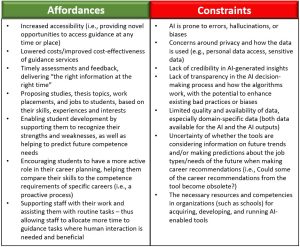
Tool-Specific Affordances and Constraints
The following table summarizes the primary affordances and constraints of the three specific AI-powered tools discussed in this chapter.
Table 3 – Comparison of Tool-Specific Affordances and Constraints
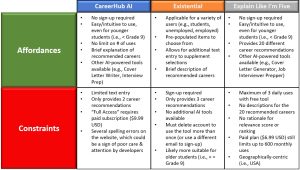
Based on these affordances and constraints, the primary recommendation is to consider the age and cognitive ability of the users when choosing an AI-powered tool to support the career exploration and guidance process – selecting the tool most appropriate for the intended audience and purpose.

The Process
The following outlines the steps (process) to complete an assessment and generate career recommendations using one of the three specific AI-powered tools discussed in this chapter (i.e., Existential). Existential was chosen as the example, as it was the most “sophisticated” of the three tools researched (i.e., involved the most steps/required more user input, compared to the other two tools).
1. Visit Website: Access the Existential website by visiting https://getexistential.com/
2. Get Started: Click the “Get Started for Free” button.
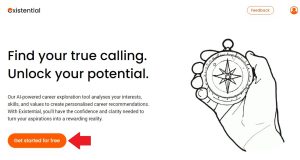
<strong; text-align: initial;”>3. Choose Your Current Situation: Select one of the four options provided in the dialogue box which best represents why you are using the tool, and click the “Confirm” button.
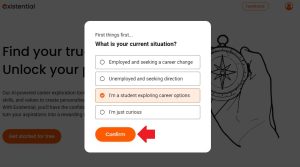
4. Sign-up: Enter the email address and password you would like to use to sign up for an account in the dialogue box, and click the “Sign up” button.1 Alternatively, if users have a pre-existing Google account, they can click on the “Sign up with Google” button and select the corresponding Google account.
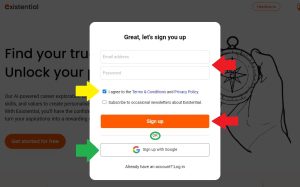
5. Begin the Assessment: After signing up, a welcome page will pop up. To proceed with the assessment, click the “Start discovery button.
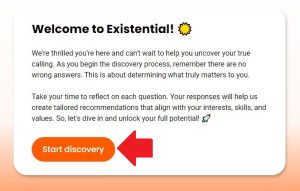
6. Identify Your Interests: A dialogue box will appear, listing different pre-populated text options/buttons, each representing a potential interest.2 Click on the text buttons which match your interests, if any. Once you have selected/entered all of your information, click the “Save and continue” button.
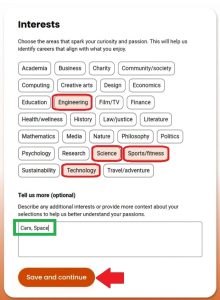
7. Identify Your Skills: A dialogue box will appear, listing different pre-populated text options/buttons, each representing a skill (strength or ability).2 Select up to five skills by clicking the corresponding text buttons.3 Once you have selected/entered all of your information, click the “Save and continue” button.
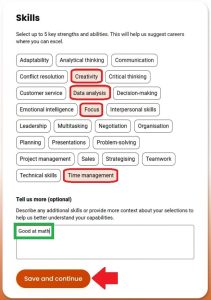
8. Identify Your Work Values: A dialogue box will appear listing different pre-populated text options/buttons, each representing what you value from a work environment.2 Select up to five values by clicking the corresponding text buttons.3 Once you have selected/entered all of your information, click the “Save and continuebutton.
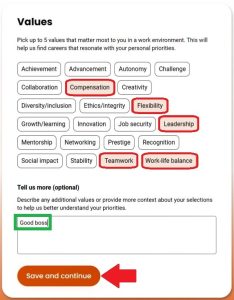
9. Enter Your Work Experience/Education: A dialogue box will appear, providing several entry fields (i.e., dropdown menus and text boxes) to be completed relating to your work experience and level of education.2 Fill in each entry field to the best of your ability (skipping any fields that are not applicable).4 Once you have selected/entered all of your information, click the “Save and continue” button.
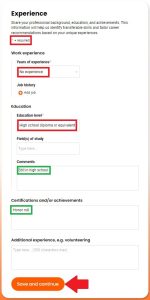
10. Enter Your Personal Details and Preferences: A final dialogue box will appear, again providing several entry fields (i.e., dropdown menus and text boxes) to be completed relating to your personal information and preferences.2 Fill in each entry field to the best of your ability (skipping any fields that are not applicable).4 Once you have selected/entered all of your information, click the “Save and submit” button. The tool will then proceed to generate recommendations for you.
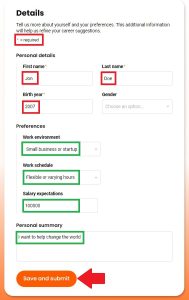
11. Explore the Results: Once the tool generates recommendations based on your inputs, you will be presented with “Your Top 3 Recommendations”.5 You can review the summary text provided for each career recommendation, advancing to the next recommendation by clicking the “right-arrow” button: ![]()
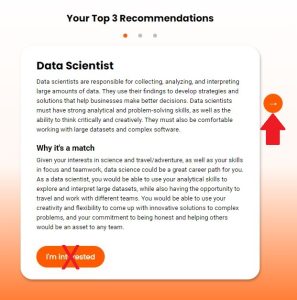
This concludes the process for using Existential to generate career recommendations.
Special Notes:
- In order to proceed, you must agree to the Terms & Conditions and Privacy Policy by checking the box provided. It is optional to subscribe to occasional newsletters about Existential. If you want to subscribe, check the box provided.
- To enhance the potential career recommendations identified by the tool, you have the option to enter additional information in the text box provided.
- You are limited to select a maximum of five (5) of the text buttons provided for these questions. Therefore, choose your “top 5”.
- Fields marked with an asterisk (*) are required. The remaining fields are optional (as outlined in green in the images).
- Clicking on the “I’m interested” button does not provide additional information; but, instead, asks you to complete an optional survey for the developer.
Prompt Engineering
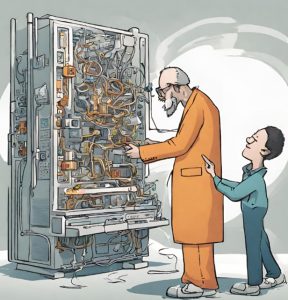
The three specific AI-powered tools discussed in this chapter (i.e., CareerHub AI, Existential, Explain Like I’m Five) do not require prompts like other AI tools (e.g., ChatGPT). Instead, these tools typically consist of pre-determined questions and ask the users to provide answers to the questions, by either having them select from options provided (i.e., dropdown menus and text buttons), and/or enter text values into the blank fields provided (with some instructions on what to enter). Limiting the requirements for user prompts in these tools helps to avoid user confusion and mitigate against the risk of “garbage in, garbage out.” However, by limiting user prompts, there is less autonomy in the hands of the user to interact with and shape the outputs generated.
One prompt recommendation to optimize the results from AI-powered tools for career exploration and guidance is for users to provide as many inputs as possible when the tools allow for text entry. Providing extra details and context will help the tool generate more customized and specific career recommendations.
Recommendations

Alternative AI-Powered Tools
While not included in the research completed for this chapter, alternative AI-powered tools that could be considered for career exploration and guidance include:
If students, teachers, and/or advisors seek a more advanced AI-powered career recommendation tool, Career Explorer (by sokanu) provides a free career test. Career Explorer uses advanced machine learning, psychometrics, and career satisfaction data to “reimagine what a career test can be.” In order to take the test, users must create a profile. The career test is extensive (i.e., takes approximately 30 minutes to complete) and asks much more detailed questions, requiring deeper self-reflection and introspection compared to the three AI-powered tools discussed in this chapter. Therefore, Career Explorer is recommended for students closer to graduation (i.e., Grade 11-12), post-secondary students, and adults; and, is not a tool geared towards younger students.
Additional Resources
Two non-profit organizations that aim to advance research and education in career counselling and career development in Canada include CERIC and the Canadian Career Development Foundation (CCDF). CERIC and CCDF have a plethora of training and resources available to the public, including career counselling professionals, educators, parents, etc. For more information, visit:
To learn more about how AI is transforming many industries, including education, the following articles are recommended:
- The Age of AI Has Begun
- How AI and Data Could Personalize Higher Education
- Leveraging Artificial Intelligence (AI) in Post-Secondary Career Advising
For additional materials and exercises on critical media literacy in the Information Age, Historica Canada, a charitable organization supported by various sources (e.g., governments, corporate sponsors, individuals), has created a Critical Digital Literacy Education Guide. This guide is meant to complement provincial and territorial education curricula:
Summary

Developing ideas and deciding what career path to take can be one of individuals’ most important, and most challenging, life decisions. According to Gati and Kulcsar (2021), the goal of those guiding students on careers is facilitating decision-making and increasing the likelihood of a desirable outcome. AI-powered tools have risen in availability, popularity, and potential uses, creating new opportunities and challenges for many industries (including education). One possible use of AI-powered tools in education is to support and enhance the career exploration and guidance process available to students.
While technology such as AI can support students in producing potential ideas for different careers, AI still needs a lot of training and further development before it can fully meet its potential (Gates, 2023; Rouhiainen, 2019). Further, even once the technology is perfected, there will still be a great need for human interaction – since it is more likely that humans will accept AI systems as a decision-making support system for career exploration and guidance rather than as a substitute for humans in decision making (Gati & Kulcsar, 2021). As such, using AI-powered tools for career exploration and guidance is envisioned as a process where human and artificial competencies are combined synergistically, improving career decision-making. This integrated approach will maximize the potential benefits and help moderate the risks of using such technology (Westman et al., 2021).
To conclude, Mollick and Mollick (2023) articulate the balancing act of using AI for applications in education, such as supporting students with career exploration and guidance.
By sharing the advantages, as well as the risks of these new approaches, educators and students can begin to work together to come up with ways to train students to use AI responsibly, in ways that enhance both their education and life outcomes. The challenges around AI remain significant, as do the opportunities. Only by learning to use these new tools firsthand can students begin to understand their implications, and prepare themselves for a world where AI forms an important part of their lives. (p. 42)
Informative Presentation
References
Literature
CERIC. (2023). Career Development in 2040: 10 Major Changes Impacting the Future of Work and Workers in Canada. https://ceric.ca/projects/career-development-in-2040-how-the-changing-nature-of-work-will-impact-the-concept-of-careers-and-the-role-and-identity-of-career-developers/
Gates, B. (2023, March 21). A New Era. The Age of AI has begun. Artificial intelligence is as revolutionary as mobile phones and the Internet. Gates Notes. https://www.gatesnotes.com/The-Age-of-AI-Has-Begun
Gati, I., & Kulcsar, V. (2021). Making better career decisions: From challenges to opportunities. Journal of Vocational Behavior, 126, 103545, 1-18.
Historica Canada. (2023). Critical Digital Literacy Education Guide. http://education.historicacanada.ca/en/tools/645
Mollick, E., & Mollick, L. (2023). Assigning AI: Seven approaches for students, with prompts. Social Science Research Network. http://dx.doi.org/10.2139/ssrn.4475995
Organisation for Economic Co-operation and Development (OECD). (2004). Career Guidance and Public Policy: Bridging the Gap. https://doi.org/10.1787/9789264105669-en
Reddy, P. (2023, April 12). Leveraging Artificial Intelligence (AI) in Post-Secondary Career Advising. Higher Education Digest. https://www.highereducationdigest.com/leveraging-artificial-intelligence-ai-in-post-secondary-career-advising/
Rouhiainen, L. (2019, October 14). How AI and Data Could Personalize Higher Education. Harvard Business Review. https://hbr.org/2019/10/how-ai-and-data-could-personalize-higher-education
Westman, S., Kauttonen, J., Klemetti, A., Korhonen, N., Manninen, M., Mononen, A., Niittymaki, S., & Paananen, H. (2021). Artificial Intelligence for Career Guidance-Current Requirements and Prospects for the Future. IAFOR Journal of Education, 9(4), 43-62.
Tools/Software
- AI text-to-image generator (Magic Media by Canva): https://www.canva.com/ai-image-generator/
- Career Exploration Tool (by Experiential): https://getexistential.com/
- Career Explorer (by sokanu): https://www.careerexplorer.com/career-test/
- Career Idea Generator (by Explain Like I’m Five): https://explainlikeimfive.io/ai-career-idea-generator/
- Discover Your Career Path (by CareerHub AI): https://careerhub-ai.com/CareerPath
- Screen Capture (by Screencastify): https://www.screencastify.com/
- Video Presentation (by Canva): https://www.canva.com/
- Video Presentation Music (by bensound): https://www.bensound.com/free-music-for-videos
Acknowledgement of AI Use
This chapter was completed with the assistance of two AI tools. Images were created using Canva’s Magic Media, an AI text-to-image generator. Grammarly Premium, a generative AI text editing tool, improved style, tone, and clarity.
- Merriam-Webster Dictionary defines the Information Age as: “the modern age regarded as a time in which information has become a commodity that is quickly and widely disseminated and easily available especially through the use of computer technology." ↵

